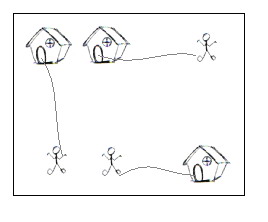Going Home
Time Limit: 10000/5000 MS (Java/Others) Memory Limit: 65536/32768 K (Java/Others)Total Submission(s): 3125 Accepted Submission(s): 1590
Problem Description
On a grid map there are n little men and n houses. In each unit time, every little man can move one unit step, either horizontally, or vertically, to an adjacent point. For each little man, you need to pay a $1 travel fee for every step he moves, until he enters
a house. The task is complicated with the restriction that each house can accommodate only one little man.
Your task is to compute the minimum amount of money you need to pay in order to send these n little men into those n different houses. The input is a map of the scenario, a '.' means an empty space, an 'H' represents a house on that point, and am 'm' indicates there is a little man on that point.

You can think of each point on the grid map as a quite large square, so it can hold n little men at the same time; also, it is okay if a little man steps on a grid with a house without entering that house.
Your task is to compute the minimum amount of money you need to pay in order to send these n little men into those n different houses. The input is a map of the scenario, a '.' means an empty space, an 'H' represents a house on that point, and am 'm' indicates there is a little man on that point.

You can think of each point on the grid map as a quite large square, so it can hold n little men at the same time; also, it is okay if a little man steps on a grid with a house without entering that house.
Input
There are one or more test cases in the input. Each case starts with a line giving two integers N and M, where N is the number of rows of the map, and M is the number of columns. The rest of the input will be N lines describing the map. You may assume both
N and M are between 2 and 100, inclusive. There will be the same number of 'H's and 'm's on the map; and there will be at most 100 houses. Input will terminate with 0 0 for N and M.
Output
For each test case, output one line with the single integer, which is the minimum amount, in dollars, you need to pay.
Sample Input
2 2 .m H. 5 5 HH..m ..... ..... ..... mm..H 7 8 ...H.... ...H.... ...H.... mmmHmmmm ...H.... ...H.... ...H.... 0 0
Sample Output
2 10 28
题意:把H和m一一配对。他们所需走的最小步数和 为多少。
做法:用bfs 先找出 随意 H 和 m 直接的最小步数。记录下来。 然后像二分图一样建图。 起点到 全部home 流量1,费用0。 home 和man 之间的费用为距离,流量1,man和终点ee之间流量1,费用0。 建图完。然后用最小费用最大流 跑一边就ok了。
#include <cstdio>
#include <iostream>
#include <cmath>
#include <cstring>
#include <vector>
#include <stdlib.h>
#include <queue>
#include <map>
#include <algorithm>
using namespace std;
const int MAXN = 10100;
const int MAXM = 30000000;
const int INF = 0x3f3f3f3f;
struct Edge
{
int to,next,cap,flow,cost;
}edge[MAXM];
int head[MAXN],tol;
int pre[MAXN],dis[MAXN];
bool vis[MAXN];
int N;//节点总个数,节点编号从0~N-1
void init(int n)
{
N = n;
tol = 0;
memset(head,-1,sizeof(head));
}
void addedge(int u,int v,int cap,int cost)
{
edge[tol].to = v;
edge[tol].cap = cap;
edge[tol].cost = cost;
edge[tol].flow = 0;
edge[tol].next = head[u];
head[u] = tol++;
edge[tol].to = u;
edge[tol].cap = 0;
edge[tol].cost = -cost;
edge[tol].flow = 0;
edge[tol].next = head[v];
head[v] = tol++;
}
bool spfa(int s,int t)
{
queue<int>q;
for(int i = 0;i < N;i++)
{
dis[i] = INF;
vis[i] = false;
pre[i] = -1;
}
dis[s] = 0;
vis[s] = true;
q.push(s);
while(!q.empty())
{
int u = q.front();
q.pop();
vis[u] = false;
for(int i = head[u]; i != -1;i = edge[i].next)
{
int v = edge[i].to;
if(edge[i].cap > edge[i].flow &&
dis[v] > dis[u] + edge[i].cost )
{
dis[v] = dis[u] + edge[i].cost;
pre[v] = i;
if(!vis[v])
{
vis[v] = true;
q.push(v);
}
}
}
}
if(pre[t] == -1)return false;
else return true;
}
//返回的是最大流。 cost存的是最小费用
int minCostMaxflow(int s,int t,int &cost)
{
int flow = 0;
cost = 0;
while(spfa(s,t))
{
int Min = INF;
for(int i = pre[t];i != -1;i = pre[edge[i^1].to])
{
if(Min > edge[i].cap - edge[i].flow)
Min = edge[i].cap - edge[i].flow;
}
for(int i = pre[t];i != -1;i = pre[edge[i^1].to])
{
edge[i].flow += Min;
edge[i^1].flow -= Min;
cost += edge[i].cost * Min;
}
flow += Min;
}
return flow;
}
int n,m;
struct node
{
int x,y,bu;
};
//addedge(int u,int v,int cap,int cost)
char mp[110][110];//地图
char num[110][110];//点查 号
int mp_dis[110][110];//号 号距离 前 home 后 men
int mp_vis[110][110];
int dir[4][2]={1,0,0,1,0,-1,-1,0};
void bfs(int x,int y)
{
memset(mp_vis,-1,sizeof mp_vis);
queue<node> q;
node sta,nw,tem;
sta.bu=0;
sta.x=x;
sta.y=y;
q.push(sta);
while(!q.empty())
{
nw=q.front();
q.pop();
if(mp[nw.x][nw.y]=='m')
mp_dis[num[x][y]][num[nw.x][nw.y]]=nw.bu;
for(int i=0;i<4;i++)
{
int xx=nw.x+dir[i][0];
int yy=nw.y+dir[i][1];
if(xx<0||xx>=n||yy<0||yy>=m)
continue;
if(mp_vis[xx][yy]!=-1&&nw.bu+1>=mp_vis[xx][yy])
continue;
tem.x=xx;
tem.y=yy;
mp_vis[xx][yy]=tem.bu=nw.bu+1;
q.push(tem);
}
}
}
int main()
{
while(cin>>n>>m,n||m)
{
for(int i=0;i<n;i++)
{
scanf("%s",mp[i]);
}
int home,man;
home=man=0;
for(int i=0;i<n;i++)
{
for(int j=0;j<m;j++)
{
if(mp[i][j]=='H')
num[i][j]=home++;
if(mp[i][j]=='m')
num[i][j]=man++;
}
}
for(int i=0;i<n;i++)
{
for(int j=0;j<m;j++)
{
if(mp[i][j]=='H')
bfs(i,j);
}
}
int ss=home+man;
int ee=home+man+1;
init(home+man+2);
for(int i=0;i<home;i++)
{
for(int j=0;j<man;j++)
{
addedge(i,home+j,1,mp_dis[i][j]);
}
}
for(int i=0;i<home;i++)
addedge(ss,i,1,0);
for(int i=0;i<man;i++)
addedge(home+i,ee,1,0);
/*
for(int i=0;i<n;i++)
{
for(int j=0;j<m;j++)
{
printf("%c%d ",mp[i][j],num[i][j]);
}
puts("");
}
for(int i=0;i<home;i++)
{
for(int j=0;j<man;j++)
{
printf("%d ",mp_dis[i][j]);
}
puts("");
}
*/
int ans;
minCostMaxflow(ss,ee,ans);
printf("%d
",ans);
}
return 0;
}
/*
2 2
.m
H.
5 5
HH..m
.....
.....
.....
mm..H
7 8
...H....
...H....
...H....
mmmHmmmm
...H....
...H....
...H....
0 0
*/